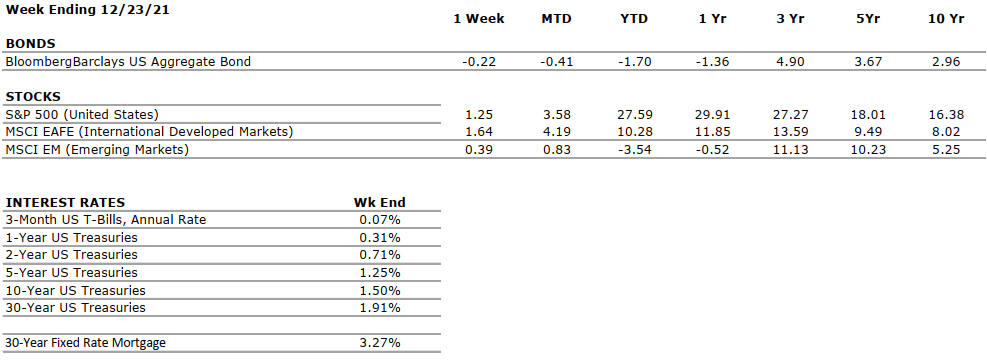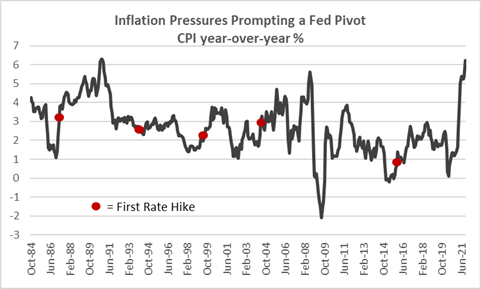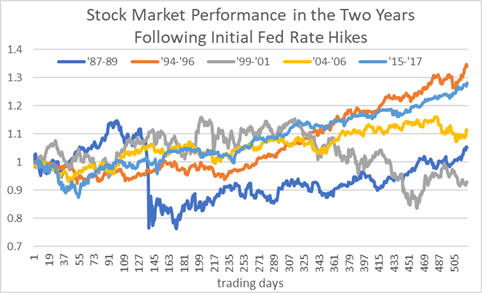Our offices will be open during normal business hours this week, including New Year’s Eve (Friday).
Monthly Archives: December 2021
Team VNFA In the News

Our Head of Investments, Bill Henderson, is featured in a Titan Investors online video interview called Titan Talks. Watch the recording shared on LinkedIn and hear his take on some key market questions:https://www.linkedin.com/feed/update/urn:li:activity:6879422861652586496
Current Market Observations
by William Henderson, Vice President / Head of Investments
A shortened Christmas Holiday week pushed markets higher even in the face of increased omicron variant threats and global travel snafus. The Dow Jones Industrial Average rose +0.2%, the S&P 500 Index gained +1.2%, and the NASDAQ gained a healthy +3.1%. Further, year-to-date returns remain well into near-record territory for 2021. Year-to-date, the Dow Jones Industrial Average has returned +19.7%, the S&P 500 Index +27.6% and the NASDAQ +22.2% giving us solid returns across all market sectors. With the healthy returns in risk assets, as expected, bonds sold off. The 10-year U.S. Treasury bond rose by nine basis points to close the week at 1.50%. The fixed income markets react as quickly as the stock market to good news or bad news and each market reminds us why investors own each asset class. Equities remain a portfolio’s return generator and bonds remain a portfolio’s risk management tool.
As mentioned above, the week gave us mixed news on the pandemic and its impact on the U.S. economy and financial markets. Cases of the omicron variant spread rapidly in pockets of the country, and the government announced an initiative to distribute COVID-19 tests to the public for free. Lastly, regulators approved two new pills that will be available by prescription for those who are sick with COVID-19.
In a revision to last quarter’s GDP, the U.S. government reported economic growth last quarter was slightly stronger than it had estimated previously. In its final estimate released last Wednesday, GDP growth in the third quarter was 2.3%, an upward revision from the original release of 2.1%. By comparison, GDP accelerated at annual rates of 6.4% and 6.7% in the first and second quarters of 2021, respectively. A report on Bloomberg showed that Christmas shopping, both in person “bricks and mortar” and online was much stronger than 2020. According to the report by Mastercard SpendingPulse, U.S. holiday sales jumped 8.5% from last year as consumers spent more money on clothes, jewelry, and electronics. Sales boomed across the board during the holiday season defined as November 1 to December 24. Many consumers were savvy shoppers and started earlier than normal, most likely due to widely reported supply chain concerns, which in the end, were largely unfounded rumors as most retailers were plentifully stocked with goods. As we move into 2022, it is important to keep the markets in perspective. Certainly, central banks globally are taking a more hawkish tone and higher short-term rates are a given next year, but that information is already priced into equities. Two questions are typically bantered about: 1) Is the market going higher or lower today? 2) Is today a good day to buy (invest)? And my answer to both questions is always the same – YES. Yes, the markets will go up or down today and YES, today is a good day to buy (invest). Long-term positive returns on investment portfolios are driven by long-term investment plans and a commitment to sticking to your investment plan. We’ve seen this all year as the market rallies back as quickly as it sold off. Perspective and commitment are what matter the most.
Of Intere$t
by Thomas M. Riddle, CPA, CFP®, Founder & Chairman
A group of decision makers at the Federal Reserve Bank (the “FED”) meets periodically during the year. Last week’s meeting led me to strongly suspect the FED will raise interest rates sometime in 2022 and continue through 2023. This action will increase interest rates on variable rate loans such as home equity loans. The reason for the increase is that many home equity loans use a formula to compute interest due on the loan such as the Prime Rate (currently 3.25%) plus 1%, for example. During 2022, some experts are forecasting the Prime Rate may rise from 3.25% to 3.75% – 4%. And, to 5% by the end of 2023. That means borrowers may see their variable rate home equity loan rate soar to 6% during the next two years.
ALERT: Variable rate home equity loan rates will rise in 2022 and 2023 so now is the time to refinance using a fixed rate home equity loan. Another viable option is to combine the variable rate home equity loan with your mortgage and consolidate into a single fixed rate mortgage. Not every bank offers a fixed rate home equity loan. I have surveyed banks in the Lehigh Valley, and I have located two banks which do. Contact me at triddle@valleynationalgroup.com and I will be happy to share the information with you.
PERSONAL NOTES: My family and I are well. My two daughters, their husbands along with my four grandchildren live only 10 miles away (all in the same development). There is a well-worn groove in the road between my house and theirs! Grandchildren are powerful magnets.
The Numbers & “Heat Map”
THE NUMBERS
 Sources: Index Returns: Morningstar Workstation. Past performance is no guarantee of future results. Indices are unmanaged and cannot be invested into directly. Three, five and ten year returns are annualized. Interest Rates: Federal Reserve, Mortgage Bankers Association.
Sources: Index Returns: Morningstar Workstation. Past performance is no guarantee of future results. Indices are unmanaged and cannot be invested into directly. Three, five and ten year returns are annualized. Interest Rates: Federal Reserve, Mortgage Bankers Association.
MARKET HEAT MAP
The health of the economy is a key driver of long-term returns in the stock market. Below, we assess the key economic conditions that we believe are of particular importance to investors.
|
US ECONOMY |
||
|
CONSUMER HEALTH |
POSITIVE |
U.S. GDP growth decelerated to a 2% annualized pace in Q3. The slowdown was driven primarily by supply chain constraints. Economists expect a modest acceleration in Q4. Early high-frequency data (shopping, travel, movie ticket sales) is showing some slowing. Holiday retails sales numbers will be important to gauge consumer behavior. |
|
CORPORATE EARNINGS |
POSITIVE |
Huge year-over-year increases in corporate earnings are likely to decelerate in 2022 as CapEx begins to have an impact on income statements. The supply chain disruptions are waning but we may have to take omicron shutdowns into account. |
|
EMPLOYMENT |
POSITIVE |
The unemployment rate is down to 4.2%, as of November. The labor market is very tight at present as many employers, particularly in the Leisure and Logistics sectors, are struggling to fully staff because the labor participation rate remains below pre-COVID levels. The labor shortage is one of the causes of the global supply chain glut. |
|
INFLATION |
NEGATIVE |
CPI rose 6.8% year-over-year in November, the highest increase since 1982, driven by the global supply chain backlog and continued consumer pent up demand. Will inflation be transitory or permanent? Powell may remove “transitory” from his testimony this week. |
|
FISCAL POLICY |
NEUTRAL |
The Build Back Better Bill has been pushed into 2022 in a scaled back $1.8 trillion version as Senator Manchin continues to hold back support. The economy seems to be digesting a new world where fiscal policy is no longer considered an economic stimulus. |
|
MONETARY POLICY |
POSITIVE |
By early 2022, all Fed bond purchases will halt. The Fed’s bond buying program works to keep interest rates low. Once tapering ends, rate hikes follow. Mid-June or sooner for rate hike? |
|
GLOBAL CONSIDERATIONS |
||
|
GEOPOLITICAL RISKS |
NEUTRAL |
The new omicron COVID-19 variant has shown up in many parts of the world. This strain seems less virulent and more reactive to boosters so its impact it still yet to be calculated. A rebound in travel and leisure now seems unsure. |
|
ECONOMIC RISKS |
NEUTRAL |
Supply chain disruptions are hampering the economy; however, demand remains very strong. While global logistics are operating far below normal efficacy, it appears the supply chain is slowly improving and may reach normalcy by mid-to-late-2022. |
The “Heat Map” is a subjective analysis based upon metrics that VNFA’s investment committee believes are important to financial markets and the economy. The “Heat Map” is designed for informational purposes only and is not intended for use as a basis for investment decisions.
Tax Corner
APTC / EIP Information Letters
The IRS announced that it would issue information letters (6419) to Advance Child Tax Credit (APTC) recipients starting in December and to recipients of the third round of the Economic Impact Payments (EIPs) (known as the stimulus payments) at the end of January. Using this information when preparing a tax return can reduce errors and delays in processing. The Service also urged taxpayers receiving these letters to make sure they hold onto them to assist them in preparing their 2021 federal tax returns in 2022.
Required Minimum Distributions (RMDs)
Effective 1/1/2022, the IRS will begin using a new table when calculating RMDs from your tax-deferred retirement plans. Once you reach age 72 (or age 70 ½ if you reached 70 ½ before 1/1/2020), you are required to take a distribution from your accounts based on the account balance at the end of the preceding calendar year and an IRS tables based on your age. The new table lowers the amount you are required to distribute annually. (You may always take a distribution larger than this amount, if needed.) The goal of lowering the required distribution is to provide retirement funds to participants for longer due to the increasing life spans.
Quote of the Week
“May all your troubles last as long as your New Year’s resolutions.” – Joey Adams
“Your Financial Choices”
Tune in Wednesday, 6 PM for a recorded episode of “Your Financial Choices” with Laurie Siebert on WDIY 88.1FM. Questions submitted online at yourfinancialchoices.com will be addressed during the next live show.
Recordings of past shows are available to listen or download at both yourfinancialchoices.com and wdiy.org.
VNFA NEWS
In observance of the Christmas Holiday, our offices will be closed on Friday, December 24.
We wish everyone a safe, warm, and happy end to 2021.
Current Market Observations
by William Henderson, Vice President / Head of Investments
The markets digested a pile of negative news last week and reacted as expected, selling off by the week’s end with all three major indexes closing lower. The Dow Jones Industrial Average fell by -1.7%, the S&P 500 Index lost -1.9%, and the tech-heavy NASDAQ fell by -3.0%. Just last week we discussed hitting records by year end and then, as has been markets’ modus operandi lately, things whipsawed the other way when some new or semi-shocking news hit the tape. Thankfully, year-to-date returns remain healthy. Year-to-date, the Dow Jones Industrial Average has returned +17.7%, the S&P 500 Index +24.7% and the NASDAQ +18.5%.
Last week the FOMC (Federal Open Market Committee) wrapped up its two-day meeting and did what the markets and economists had expected. It announced it will wind down bond purchases at a faster pace due to increased inflationary pressures on the consumer and healthy employment levels. However, there was a new “tone” in the Fed’s message that the markets read as hawkish – meaning higher rates are coming. The new outlook for rates in 2022 is showing as many as three rate hikes in the second half of the year. While not unexpected, the markets and the economy have become a little too accustomed to easy monetary policy. The chart below from Bloomberg shows how U.S. inflation, as measured by the Consumer Price Index, is higher than it has been in about 30 years, with dots indicating the timing of the Fed beginning to hike rates. The Fed’s hawkish pivot is typical behavior and standard reaction to a jump in inflationary pressures.

The omicron variant of COVID-19 is having a much bigger impact on the markets and the economy than the expectation of higher rates. We knew higher rates were coming and we believed omicron was in check but, globally and in the United States, we are seeing renewed shutdowns and closures as the omicron variant spreads more rapidly than expected. Several Broadway shows and NFL football games were canceled over the weekend just as a sense of normality was returning. Closures and cancellations are not what the economic doctor ever orders for a recovery economy. Mall activity and shopping are at decent levels and consumers are spending for the Christmas holiday. Retail sales information will be telling when released next month. It is important to note that current vaccines when taken with the booster, deliver a powerful punch to the omicron variant and most hospitalizations and severe illnesses are among the population that has yet to get vaccinated.
In our weekly
Heat Map, we moved Fiscal Policy to neutral from
positive because the Build Back Better bill looks to be dead for 2021 and
questionable for 2022. If the Biden Administration
cannot piece together a coalition to support his plan while in numerical
control of the U.S. House and Senate, their future
looks bleak, especially given 2022 is a mid-term election year. For
that reason, we believe fiscal stimulus (support for the economy from the government
rather than the Fed) will wane in 2022 and is
no longer supportive of the economy.
We do not want to be repetitive more than required but the negatives we point out above: omicron, Fed tapering, higher rates and removal of fiscal stimulus are not new worries. We have talked about and them for weeks and are well prepared. Stock markets can rally well into a Fed tightening cycle. The chart below from Bloomberg and Edward Jones, shows equity market returns, as represented by the S&P 500, during the two years following the first time the Fed began hiking rates in previous rate-hiking cycles over the last 35 years.

Everyone knows past performance is not indicative of future performance, but we can learn from history and history shows us that stock markets can do well even as liquidity tightens and monetary and fiscal stimulus wanes. Last week, as equity markets fell, the bond market provided needed risk management for portfolios. The yield on the 10-Year U.S. Treasury dropped seven basis points from the previous week to 1.41% as investors moved from risk assets, such as equities, to the relative safety of bonds. With only a few trading days left in the year and news, but not “new” news hitting the tape every day, investors will be challenged and whipsawed as their investment plans are tested. We remain focused on the long term rather than the short term and believe that the economy remains well on its way to a strong recovery and a healthy 2022.
